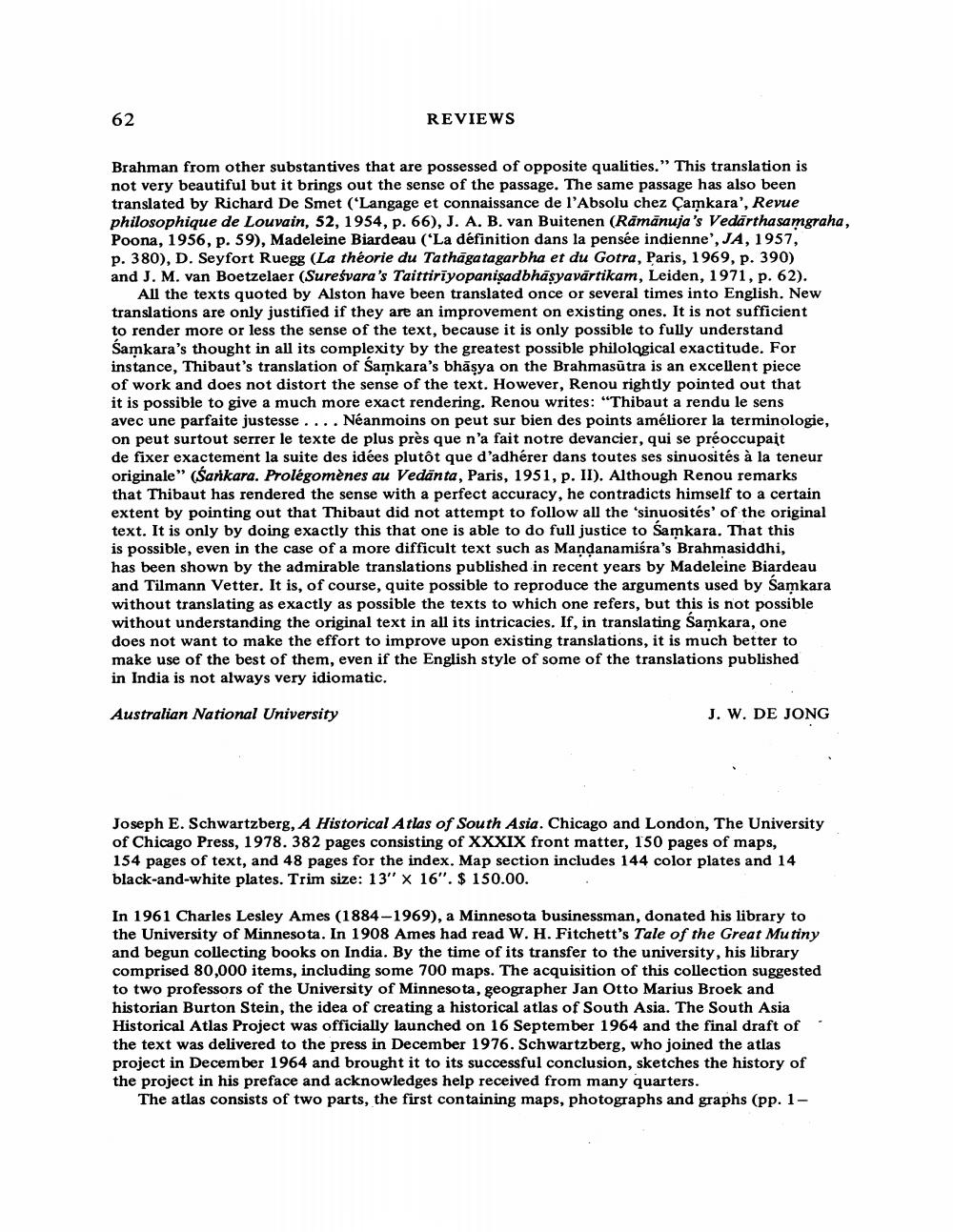Book Title: Book Reviews Author(s): J W De Jong Publisher: J W De Jong View full book textPage 4
________________ 62 REVIEWS Brahman from other substantives that are possessed of opposite qualities." This translation is not very beautiful but it brings out the sense of the passage. The same passage has also been translated by Richard De Smet ('Langage et connaissance de l'Absolu chez Çamkara', Revue philosophique de Louvain, 52, 1954, p. 66), J. A. B. van Buitenen (Ramanuja's Vedärtha samgraha, Poona, 1956, p. 59), Madeleine Biardeau ('La définition dans la pensée indienne', JA, 1957, p. 380), D. Seyfort Ruegg (La théorie du Tathāgatagarbha et du Gotra, Paris, 1969, p. 390) and J. M. van Boetzelaer (Sureśvara's Taittiriyopanişadbhāsyavārtikam, Leiden, 1971, p. 62). All the texts quoted by Alston have been translated once or several times into English. New translations are only justified if they are an improvement on existing ones. It is not sufficient to render more or less the sense of the text, because it is only possible to fully understand Samkara's thought in all its complexity by the greatest possible philological exactitude. For instance, Thibaut's translation of Samkara's bhāsya on the Brahmasūtra is an excellent piece of work and does not distort the sense of the text. However, Renou rightly pointed out that it is possible to give a much more exact rendering. Renou writes: "Thibaut a rendu le sens avec une parfaite justesse.... Néanmoins on peut sur bien des points améliorer la terminologie, on peut surtout serrer le texte de plus près que n'a fait notre devancier, qui se préoccupait de fixer exactement la suite des idées plutôt que d'adhérer dans toutes ses sinuosités à la teneur originale" (Sankara. Prolegomènes au Vedānta, Paris, 1951, p. II). Although Renou remarks that Thibaut has rendered the sense with a perfect accuracy, he contradicts himself to a certain extent by pointing out that Thibaut did not attempt to follow all the 'sinuosités' of the original text. It is only by doing exactly this that one is able to do full justice to Samkara. That this is possible, even in the case of a more difficult text such as Mandanamiśra's Brahmasiddhi, has been shown by the admirable translations published in recent years by Madeleine Biardeau and Tilmann Vetter. It is, of course, quite possible to reproduce the arguments used by Samkara without translating as exactly as possible the texts to which one refers, but this is not possible without understanding the original text in all its intricacies. If, in translating Samkara, one does not want to make the effort to improve upon existing translations, it is much better to make use of the best of them, even if the English style of some of the translations published in India is not always very idiomatic. Australian National University J. W. DE JONG Joseph E. Schwartzberg, A Historical Atlas of South Asia. Chicago and London, The University of Chicago Press, 1978. 382 pages consisting of XXXIX front matter, 150 pages of maps, 154 pages of text, and 48 pages for the index.Map section includes 144 color plates and 14 black-and-white plates. Trim size: 13" X 16". $ 150.00. In 1961 Charles Lesley Ames (1884-1969), a Minnesota businessman, donated his library to the University of Minnesota. In 1908 Ames had read W. H. Fitchett's Tale of the Great Mutiny and begun collecting books on India. By the time of its transfer to the university, his library comprised 80,000 items, including some 700 maps. The acquisition of this collection suggested to two professors of the University of Minnesota, geographer Jan Otto Marius Broek and historian Burton Stein, the idea of creating a historical atlas of South Asia. The South Asia Historical Atlas Project was officially launched on 16 September 1964 and the final draft of the text was delivered to the press in December 1976. Schwartzberg, who joined the atlas project in December 1964 and brought it to its successful conclusion, sketches the history of the project in his preface and acknowledges help received from many quarters. The atlas consists of two parts, the first containing maps, photographs and graphs (pp. 1Page Navigation
1 2 3 4 5 6 7 8 9 10 11 12 13 14 15 16 17 18 19 20 21 22 23 24 25 26 27 28 29 30 31 32 33 34 35 36 37 38 39
